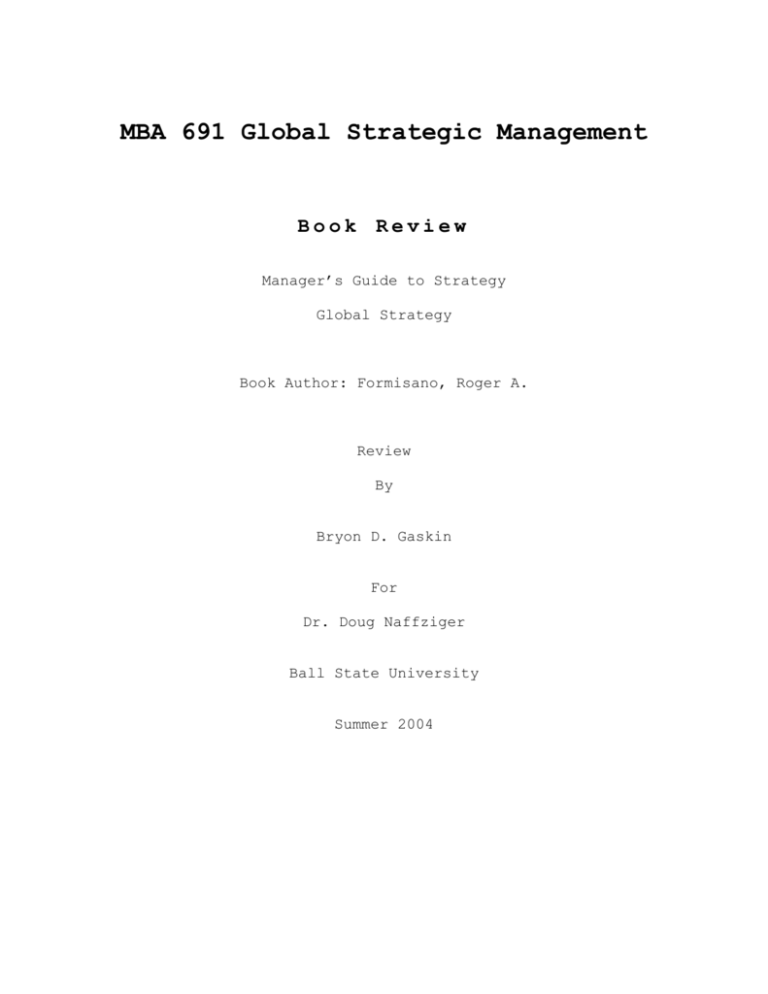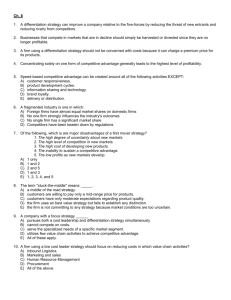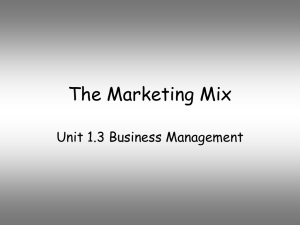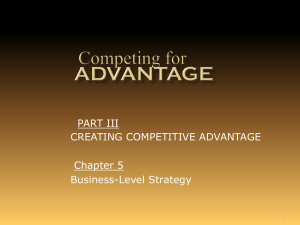MBA 691 Managers guide to strategy-Book
advertisement

MBA 691 Global Strategic Management Book Review Manager’s Guide to Strategy Global Strategy Book Author: Formisano, Roger A. Review By Bryon D. Gaskin For Dr. Doug Naffziger Ball State University Summer 2004 TABLE OF CONTENTS TABLE OF CONTENTS ............................................................................................ 2 INTRODUCTION ........................................................................................................... 3 WHAT IS BUSINESS STRATEGY? ................................................................................. 3 GOAL SETTING: ........................................................................................................... 4 VISION ......................................................................................................................... 4 STRATEGY ROAD MAP ................................................................................................ 5 STRATEGIC CHOICES .................................................................................................. 6 STRATEGIC THINKING: Optimizing Assets ..................................................................... 7 IMPLEMENTING STRATEGIC DECISIONS ..................................................................... 7 Conclusion .................................................................................................................... 8 INTRODUCTION The “game of business” is how the book starts out to describe business strategy. It likens the process that two opposing football teams go through from beginning to end. It starts with the pre-game strategy, and then both teams adjust their game plans to reflect the circumstance out on the field. They try to use their strengths to their advantage, minimize their own weaknesses, while at the same time exploiting the weakness of the competition. Each team must also respond to external macroenvironment changes such as changing weather conditions that affect both teams, internal microenvironment changes that affect only each individual team like injuries; both teams will make decisions based on score, field position, and the time. Strategy is the detailed plan a company uses to achieve success. If there was a translation tool for business terminology to sports terminology strategy would be seen as the “game plan”. The goal of the book is help its readers find the best strategy for their respective businesses and how they can use strategy to get successful business results over the long run. WHAT IS BUSINESS STRATEGY? According to the book “there are a lot of ideas around, but they aren’t all business ideas.” True business ideas have two defining characteristics, first they must meet an “unmet need” and second, they must drive transactions. Strategy can be broken down into three components, creating the strategy proposes the question, “what should we do?” Implementing the strategy defines the question, “how do we do it?” Evaluating the strategy answer the question, “how well are we doing in meeting our long term goals?” A company must answer the question “what is our business idea?” This forces companies to decide what business they are. This is usually easier for new businesses, but for established firms, this can be difficult because their business ideas have become too diluted to define. This results in a lack of direction for employees and managers, they start to loose sight of what had made the company successful in the past. Companies must also determine the answer to, “what is our advantage?” For the most part, businesses must compete with others for unmet customer needs. Companies that are successful at attracting and keeping customers must have an advantage over their rivals. Differentiation of a company’s products, services or business model can be a source of competitive advantage. However, differentiation alone is not enough; a company’s competitive advantage must “target unmet needs of customers.” Cheers! “Sometimes you want to go where everybody knows you name.” Companies like Starbucks know the answer to, “what is our product.” Starbucks sells more than just a cup of coffee they sell an experience. Companies must know what their total product is if the want to succeed. Environmental factors can have major effects on a company. A company needs to be prepared to answer the question, “What trends and new factors will change our business.” Markets, the world, population, tastes, economic factors, and technology are changing as they have always done and will continue to always do; and companies need to adjust their strategy. A very good quote from Wayne Gretzky illustrates this point, “Some people skate to the puck. I skate to where the puck is going to be.” Successful business can make adjustments to future changes. GOAL SETTING: Goals setting is the first step in strategy. If you don’t know where you want to go, then it is not important which way you go. According to Adam Smith’s concept of the “invisible hand”, maximizing shareholder value is supposed to benefit all shareholders associated with the business. This system only works if one is speaking of the long term, however, the long term means different things to different entities. To address this issue, companies need to think in “strategic time” mind frame. When a company creates a vision it often does so looking 20 years out. Strategic plans normally look out 3 to 5 years, most companies have operating plans for the current year, and publicly traded companies have operating plans prepared for the next quarter. It is import for a company to match its time frame with the markets it serves and to the rate of change in those markets. Contrary to popular opinion, time is not always on a businesses side. One does not need to look further than Kmart, Enron, or Arthur Anderson, to see that important strategic decision often measured in months instead of years. VISION Vision statements are often looked at by business people with a grain of salt. This negative perception about vision/ mission statements can be explained by the fact that they remain just that, statements, “some words on a page.” However, successful companies test out the notion of the future against achievement of the vision goals. Firms with vision that are formalized and articulated earn twice as much ROE as those without formal documented visions. Mission statements provide a blueprint for the company to follow as it moves through time. Common components of mission statements include emphasis on quality, customer satisfaction, and profitability. However, those don’t always need to be present. For example, Microsoft’s 1975 mission was “a computer on every desk in every home.” This mission statement lasted for nearly 20 years until it was switched in 2002. That illustrates an important point, “don’t cling to your mission.” With that said, there are six major areas of consideration that firms opt to chose from: Those include the following: products and services, customers, markets, employees, philosophy of doing business, and achievement. Some firms will incorporate all six of these areas of considerations, however, others chose only among them. It important to remember that the mission statement is not written in stone, and as a business changes, it may be necessary change the mission statement as the size of the business changes. STRATEGY ROAD MAP There are three very important questions a company must answer in order to create as strategy roadmap. First, “Where are we now?” A company must have a detailed assessment of what its current situation is. Second, “Where should we go?” This represents a company’s business ideas. The company must identify plausible strategic alternatives and select the best one. Which alternative is selected depends on the company’s current situation, its goals, and its analysis of the alternatives. Third, “How do we get there?” This is the most complicated of the three questions because it entails so many factors. Although there are three separate questions, it would be naïve to think of them independently. Successful strategic initiatives integrate all three questions in order to achieve the overall corporate objective. The first step in strategy performance is “Evaluating Current Performance”. For most organizations strategy performance is checked on a regular basis via such mechanisms as monthly, weekly, or daily reports. Performance needs to be measured relative to something else. That “something else” or yard stick a company uses depends on its objectives. “Environmental Analysis” is the second step. If everything remained constant, then strategy would be much easier, a business could simply rely on adjustments to the current performance of the business in order to determine its future strategy. Environmental analysis looks at events or factors in social, political, economic, regulatory, and technological climates that currently affect the business today as well as factors that will affect the business tomorrow. The following step is “Industry Analysis.” Whereas environmental analysis monitors changes in economic and social factors, industry analysis has a much narrower scope and focuses on the markets in which the company competes. Industry analysis can be broken down into the following three components: structure, industry evolution, competition. Next a company moves to “Internal Analysis.” Internal analysis is the internal review of the company’s structure, culture and resources. A company combines the information gathered in the first three steps and uses it to develop a set of strategies that will enable it to reach its goals and objectives. “Strategy Formation” takes place after a company has completed its analytical review. Now a company is ready to start thinking in a strategic mindset. SWOT analysis is a suggested method companies can use to map out clear objectives for the organization. The SWOT process attempts to clearly define strengths, weaknesses, opportunities and threats. After SWOT analysis, a company then needs to start “Developing Strategy Options.” At this point, the company is starting to find some of the answers to “How Do We Get There?” “Evaluate Options, Evaluate Results,” is the final step in the strategy road map. Successful companies learn from their experiences, goods and bad ones a like. Strategy roadmaps require continual monitoring, this goes back to the fact that the world, markets, and company itself are always changing. STRATEGIC CHOICES Take the following three firms: Wal-Mart, Kmart, and Target, all three are similar in that they are retailers, but that is where the similarity ends. Each of them market, buy, promote, merchandise, and operate differently. That being said, their results are also different. Strategic choices have to be put in place in a way that consistently supports the strategic approach of the company. Michael Porter of the Harvard Business School suggests that there are only three strategies businesses can use, known as generic strategies. Those generic strategies are the low-cost producer, industry-wide differentiation, and niche player. Each of these strategies have plus and minuses to it, which one a company selects must support the steps it has developed in its strategic road map. In fact, Porter argues that a company can choose one and only one of the three approaches. STRATEGIC THINKING: Optimizing Assets Asset optimization has its beginnings in the 1920s with the DuPont formula where ROA=Profits/Sales X Sales/Total Assets. Asset optimization is a good way for companies to start finding ways to fully utilize the assets they currently own or control before they think about investing in new things. Company must first identify what its assets are. In general there are three types of assets: people, property, and relationships. A company needs to identify its key people for the various positions. A company needs to develop initiatives to help it reach its goals. Potential initiatives include: pay for performance, outsourcing, workout, and building a business around expertise. The second class of assets is property and like people a company must identify the key property assets. Property asset categories included: land and buildings, equipment and inventory, technology, financial assets, products, and brands. Two questions b consider when looking at property assets. First, can the use of the property be increase or reconfigured so that it generates more return? Second, does it have any special or unique characteristics that make it valuable in more than on setting? Most business have three main categories of relationships; they are, customer, supplier and governmental. Of which, customer relationships tend to have the highest importance for most firms. IMPLEMENTING STRATEGIC DECISIONS Often times bringing to light why other strategies failed can help one better understand the correct way to implement strategy: An article in the Sloan Management Reviews lists the following causes of strategy implementation: top-down or lasses-faire senior management style, unclear strategy and conflicting priorities, ineffective senior management, poor vertical communication, poor coordination across functions, businesses, or borders, and inadequate down-the-line leadership skills and development. With the failures stated, this lays the ground for four guiding principles in strategy implementation. First, top management must make the entire organization believe in fulfilling the strategy. This must include people at all levels of the company. Secondly, the company must have clearly defined and communicated vision, goals, and strategy; more importantly decisions that are made must be consistent with these ideals. Communication is the key, this needs to permeate from top to bottom, bottom to top, and side to side. A sure fire way to sabotage these ideals is to make decisions that appear to be contradictory to the strategic direction of the company. If executives cannot explain their decision, it is likely that the decision needs to be rethought. Third, senior management must match the strategy with the capabilities of the firm. A strategy is useless if the company does not have the resources to achieve it. Fourth, at all of the various leadership positions in the company, leaders must have access to the tools and skills that are required to push the strategy through the different functions of the company. Empowerment and trust allow employees to do the company’s business. Having the proper skills and tools puts in their hands the best possibilities doing it successfully. Conclusion Overall the book was very good. It was written a very concise manner without a lot of hyperbolic speech, yet at the same time provided sound structural advice for the steps and process a company should go through in its strategy development. The “Manager’s Guide to Global Strategy” book has many similarities to the Pitts and Lei “Strategic Management” book, even quoting many of the same authors; the major difference in between the two books is the Pitts and Lei book puts a greater emphasis on competitive advantage than does the “Manger’s Guide” book. The “Manager’s Guide” book places most of its emphasis on the analysis and implementation of strategic process more than it does competitive advantage per se. This book would make an excellent resource for students or professionals with little or no knowledge of strategic management or professionals who just want an excellent refresher course.











